I don’t like to admit defeat to a plate of food — at least not if it looks like a normal-sized portion and there’s no good way of saving the food for later. But, skånsk äggakaka, or Scanian egg cake, is one of these dishes where I’ve had to throw in the towel (or napkin) and wobble out of the restaurant.
Don’t get me wrong — it is delicious. I’ve had most of my äggakakor at Brösarps Gästgiveri in Skåne and they know their stuff. It is just such an incredibly filling dish.
The dish is best described as a cross between a thick pancake and an omelet. You’ll often enjoy it with fried pork and lingonberries or fried apples.
Yeah, you won’t be needing much else to eat that day. And it might be a good idea to share the dish with someone (unless you’re practicing for an eating competition).
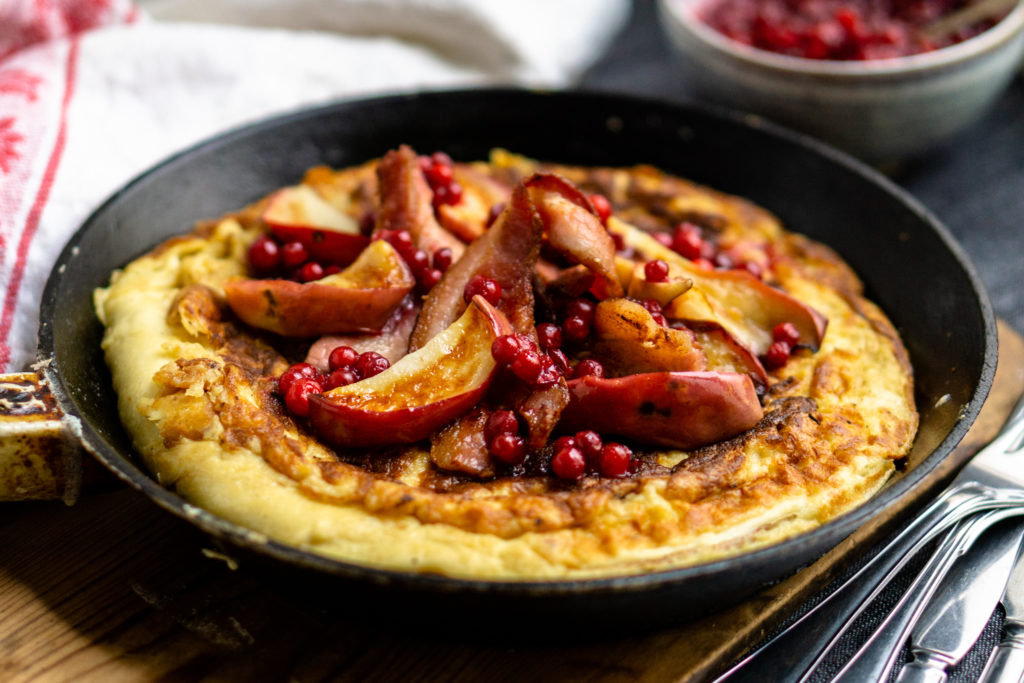
The history of the Scanian Egg Cake
In Gastronomisk kalender 1981, Kurt Genrup shares the history of the egg cake and how it became a symbol of Scania, or Skåne. Genrup classifies the egg cake as a type of pancake. Apparently, the dish was also called pork pancake (fläskpannkaka) or thick pancake with pork and egg (tjock pannkaka med fläsk och ägg).
While we think of egg cake as Scanian, there are similar dishes in the counties Halland and Blekinge during the late 1800s. Apparently, similar dishes also existed in Denmark (flaeskaeggekage) and in the North of Germany (Eierflinsen or Eierkuchen).
The egg cakes must have been massive, as they often required twenty eggs. Genrup mostly discusses the egg cake history in the 1800s. In these times, eggs were valuable for trading, so you can imagine how festive this egg-rich dish was.
For example, during Scanian parties in the 1830s, the farmers feasted on salted eel, sweet porridge, and egg cake (plus, a lot to drink). You could also bring the egg cake with you when you went to a party, eat it at festivities such as May balls, or gift it to a new mother.
How to serve egg cake
Genrup notes that during harvest time, it was popular to bring egg cake with you out in the field. Here, you’d often cut the cake into triangular pieces and ate it with your hands. To bring it with you to the field, farmers often had a special “egg cake bag”. Nordiska Museet in Stockholm has a couple of egg cake boxes preserved:
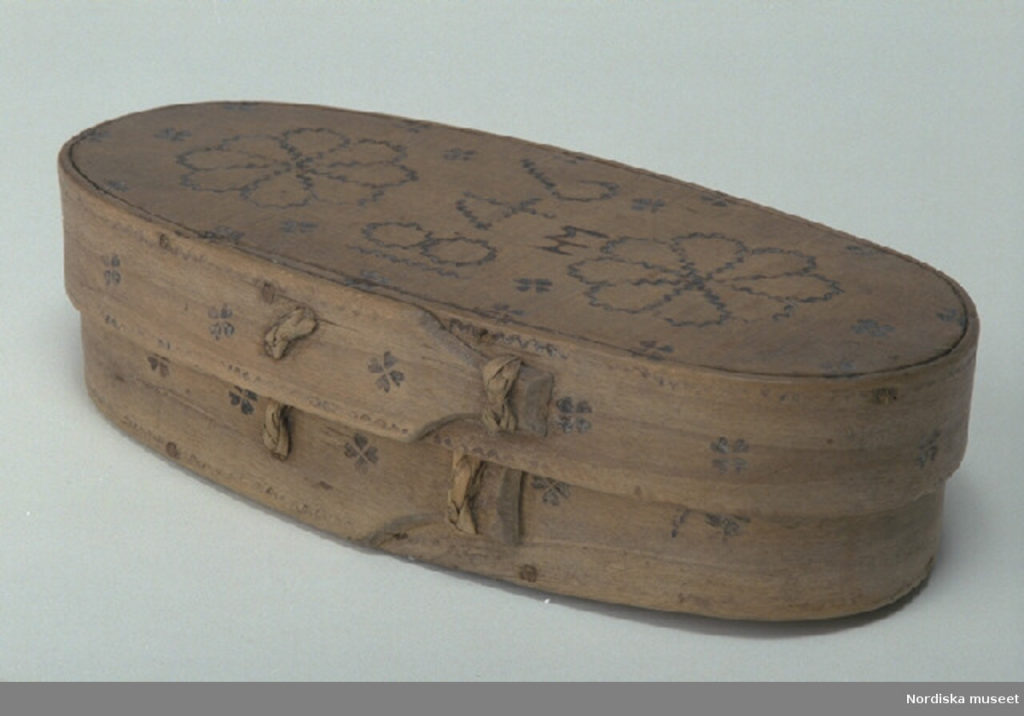
Genrup mentions that to mark a festive occasion, the egg cakes were places on dedicated plates made of ceramic. They often had beautiful decorations and figures painted on them.
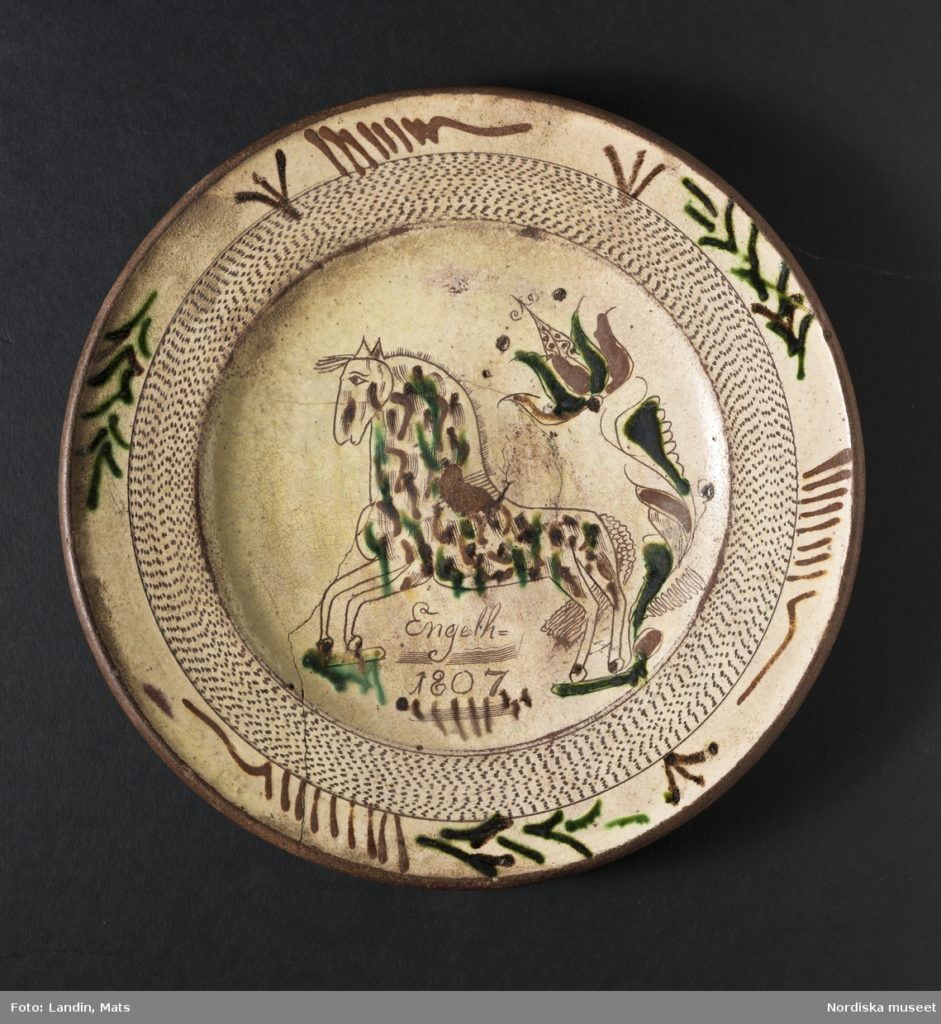
So, then we have the matter of what you serve the egg cake with.
By now, you probably think that the Swedes put pork in or on absolutely everything. How about rårakor, or pea soup? In this case, pork could be added to the batter but was often served on the side. Nowadays, the standard seems to be to fry the pork in the frying pan that you then use for the egg cake, and then serve the egg cake with the pork on top.
Genrup mentions that the dish could be flavored with cinnamon, sugar, and cardamom, although I’ve neither heard of nor tasted that version. Otherwise, lingonberry was and is a popular condiment. Some people eat fried apples with it, too.
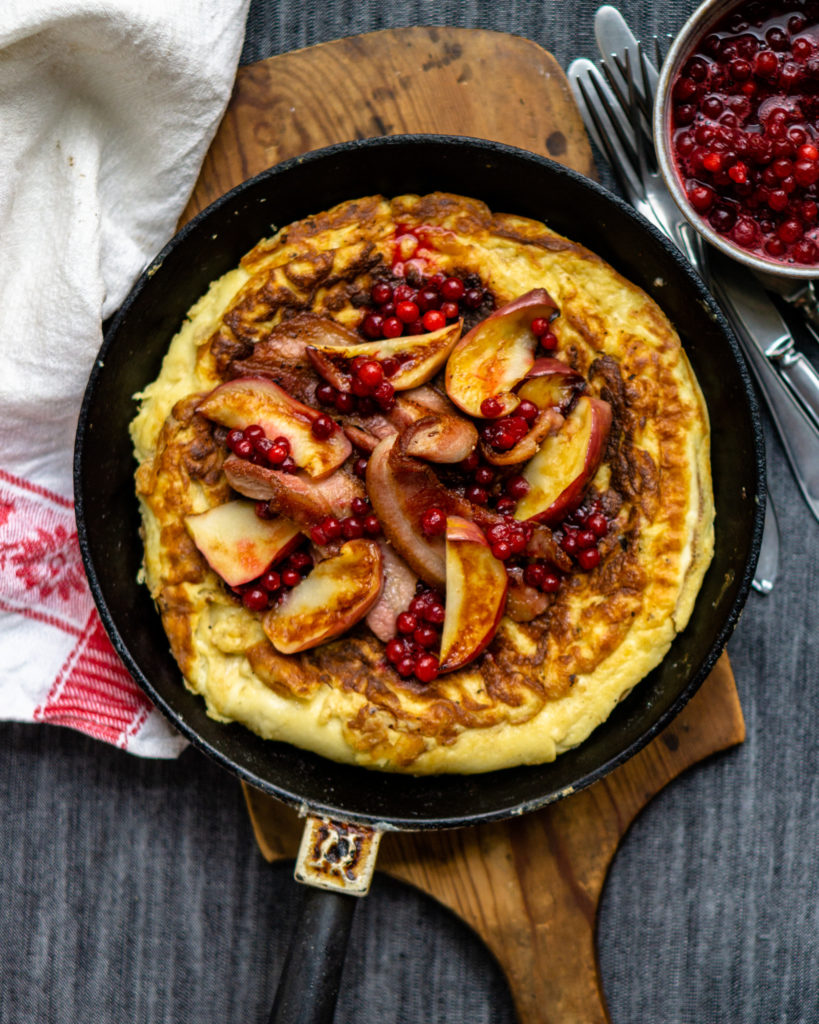
How to make Scanian Egg Cake — skånsk äggakaka
Many modern recipes start by frying the egg cake and then bakes it for a few minutes. I cook it all on the stove instead. Makes four portions.
300g sliced pork or bacon
6 eggs
1 tsp salt
2.5 dl (1 cup) flour
6 dl (2 2/5 cups) milk
For frying: butter or neutral oil
For serving (optional): fried apples, lingonberries or lingonberry jam
- Fry the pork or bacon in a frying pan, ideally a cast iron pan, with a little butter or oil until it is cooked through. Once it is cooked, remove it from the heat and place it in a covered bowl or similar to keep it warm. Don’t wash or remove the fat from the pan — you’ll be using it again for the cake.
- In a bowl, whisk the eggs with the salt so they break up. Add the flour and whisk until you have a lump-free batter. Then add the milk and whisk until it is well blended.
- Heat up the same frying pan you used for the pork and add a little butter or oil. On medium heat, add all the batter to the frying pan. Let it set for a few minutes, then use a spatula gently scrape one or a few thick sheets of egg cake from the bottom, so that new batter comes in contact with the pan’s bottom. Repeat this — you don’t want to stir, but gently move the batter around every now and then so it can set, without burning the bottom.
- You know that you’re ready to flip the cake when the sides of the egg cake come off from the pan when you nudge them, the edges and bottom have become golden, and most of the batter starts to set. Get a lid of the same size as the pan. Rinse the lid with water, then cover the pan and turn it upside down so the cake comes on top of the lid. Put the pan back on the stove and add a bit more butter or oil. Gently slide the cake down into the pan so you get the already fried side facing upwards.
- Let the egg cake cook on the second side until it turns golden and is set.
- Serve it with the pork or bacon, and maybe fried slices of apple and lingonberry jam if you have it.
Suggestions
Make a vegetarian alternative by skipping the pork and instead frying up sliced mushrooms. Butter-fried mushrooms with thyme — how about that?
For a convenient, simple, and rustic picnic food, simply add chopped, fried pork (if using) to the batter and fry as above. Once it is cool, the egg cake is easy to transport and you can eat it in large pieces with your hands.

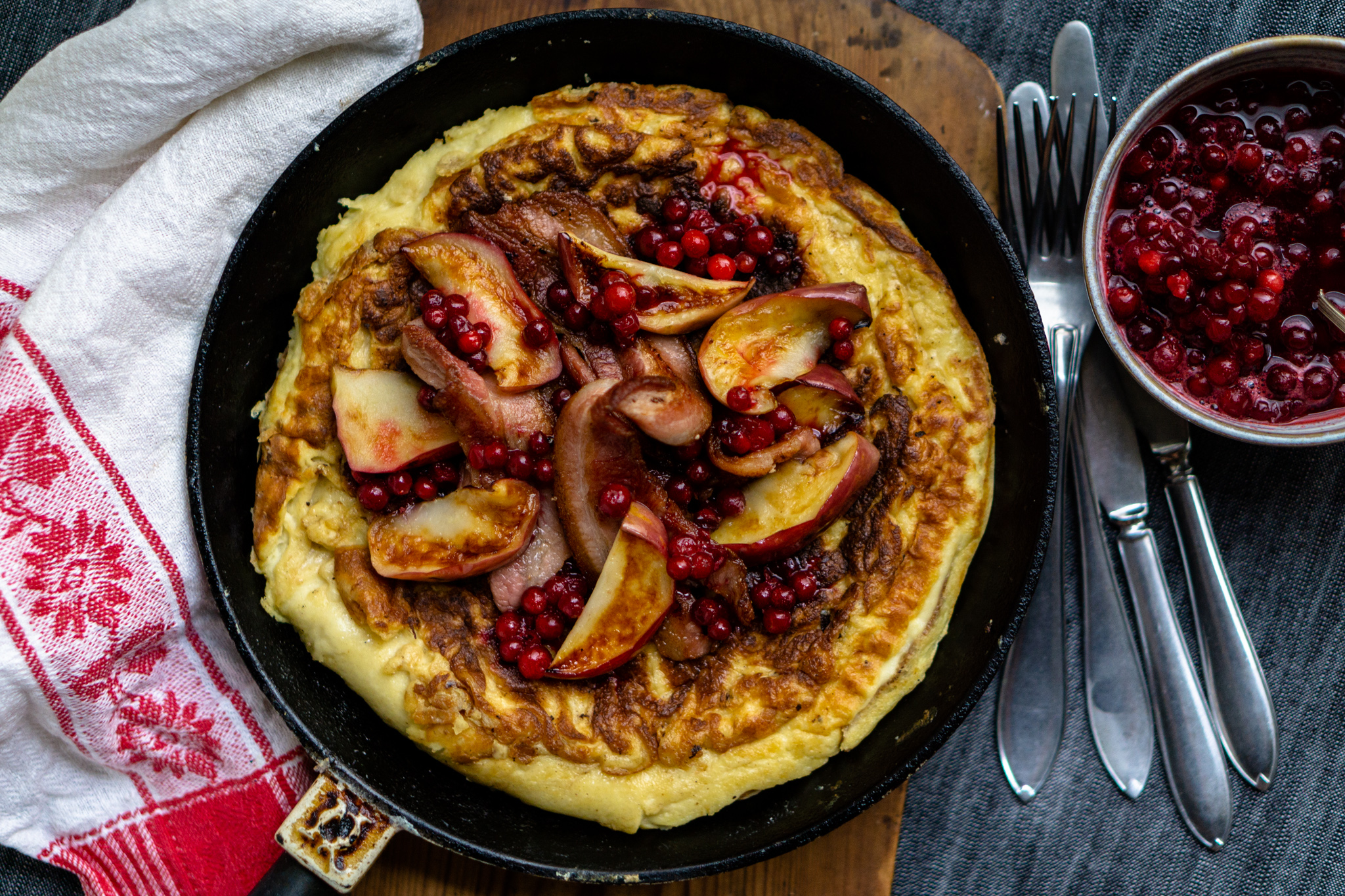

Not only am I going to make this aggakaka for my parents (in their late 80s), but I’m looking to build that box you included in the article.
Thank you very much.
Gregory, I hope they will enjoy it! If it is a bit much to eat, egg cake is a great leftover, too 🙂
Your wood-crafting skills are far beyond mine if you feel tempted by such a project as the wooden box! Here’s a beautiful video I found that shows you how to make a traditional “svepask”: https://youtu.be/5Hgr8CuMx0Y
This seems very similar Raggmunk, but without the potato…?
Deborah, I think of it as a cross between a pancake and an omelet, but you’re right that it has similarities to raggmunk. The raggmunk batter I often use is similar to a pancake batter but also includes added potato. Overall, that means fewer eggs for raggmunkar than for the egg cake.
The two biggest similarities are how the dishes are served — often with bacon and lingonberry — and that they are very filling!
Both my mother and I ate flaskpankaka since my grandmother came from Smaland and grandfather came from Vastergotland. My father came from Halland. All of them were from farm families. Once in Vastergotland while visiting family there we were served aggpankaka made from the first milk from a cow after she had calved. Very rich and very special for special guests.. I vary the portions of my flaskpankaka depending on the meal (breakfast, brunch or supper) and number of guests. Making it with wild mushrooms is great – especially chantrelles. Also can serve with lingonberries blended in unsweetened whipped cream. It is one of my favorite recipes
This may be a duplicate submission as they did not like how I entered my email address and I am not sure you got the first one.
Judith, thank you so much for your comment. There was no duplicate comment so I appreciate you entering it again, as I otherwise would have missed your interesting story.
The best-known dish made of the cow’s first milk is called “kalvdans” (“calf dance”), but after that, you could also make “råmjölkspannkaka” and it sounds like that’s what you had. How delightful! I’ve yet to try either of them but look forward to that day — it is a special treat indeed.
Thank you for sharing your tips! It all sounds delicious and your chantarelle version must be hard to beat — next time!